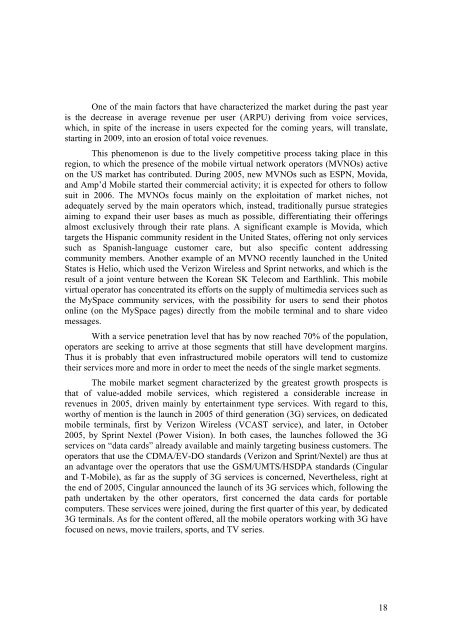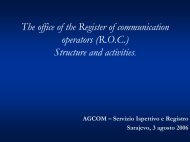Communications Regulatory Authority
Communications Regulatory Authority
Communications Regulatory Authority
Create successful ePaper yourself
Turn your PDF publications into a flip-book with our unique Google optimized e-Paper software.
One of the main factors that have characterized the market during the past year<br />
is the decrease in average revenue per user (ARPU) deriving from voice services,<br />
which, in spite of the increase in users expected for the coming years, will translate,<br />
starting in 2009, into an erosion of total voice revenues.<br />
This phenomenon is due to the lively competitive process taking place in this<br />
region, to which the presence of the mobile virtual network operators (MVNOs) active<br />
on the US market has contributed. During 2005, new MVNOs such as ESPN, Movida,<br />
and Amp’d Mobile started their commercial activity; it is expected for others to follow<br />
suit in 2006. The MVNOs focus mainly on the exploitation of market niches, not<br />
adequately served by the main operators which, instead, traditionally pursue strategies<br />
aiming to expand their user bases as much as possible, differentiating their offerings<br />
almost exclusively through their rate plans. A significant example is Movida, which<br />
targets the Hispanic community resident in the United States, offering not only services<br />
such as Spanish-language customer care, but also specific content addressing<br />
community members. Another example of an MVNO recently launched in the United<br />
States is Helio, which used the Verizon Wireless and Sprint networks, and which is the<br />
result of a joint venture between the Korean SK Telecom and Earthlink. This mobile<br />
virtual operator has concentrated its efforts on the supply of multimedia services such as<br />
the MySpace community services, with the possibility for users to send their photos<br />
online (on the MySpace pages) directly from the mobile terminal and to share video<br />
messages.<br />
With a service penetration level that has by now reached 70% of the population,<br />
operators are seeking to arrive at those segments that still have development margins.<br />
Thus it is probably that even infrastructured mobile operators will tend to customize<br />
their services more and more in order to meet the needs of the single market segments.<br />
The mobile market segment characterized by the greatest growth prospects is<br />
that of value-added mobile services, which registered a considerable increase in<br />
revenues in 2005, driven mainly by entertainment type services. With regard to this,<br />
worthy of mention is the launch in 2005 of third generation (3G) services, on dedicated<br />
mobile terminals, first by Verizon Wireless (VCAST service), and later, in October<br />
2005, by Sprint Nextel (Power Vision). In both cases, the launches followed the 3G<br />
services on “data cards” already available and mainly targeting business customers. The<br />
operators that use the CDMA/EV-DO standards (Verizon and Sprint/Nextel) are thus at<br />
an advantage over the operators that use the GSM/UMTS/HSDPA standards (Cingular<br />
and T-Mobile), as far as the supply of 3G services is concerned, Nevertheless, right at<br />
the end of 2005, Cingular announced the launch of its 3G services which, following the<br />
path undertaken by the other operators, first concerned the data cards for portable<br />
computers. These services were joined, during the first quarter of this year, by dedicated<br />
3G terminals. As for the content offered, all the mobile operators working with 3G have<br />
focused on news, movie trailers, sports, and TV series.<br />
18















